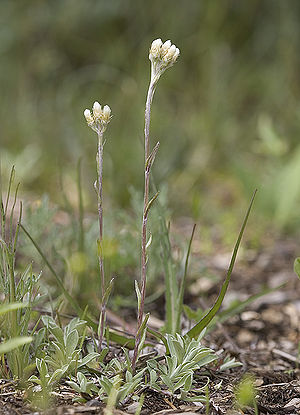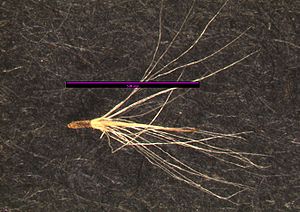Antennaria howellii
Abbreviation Code (Codon): ANHO
| Template:Taxobox name | |
|---|---|
| File:GooeyduckSeafood.jpg | |
| Four live geoducks in a seafood tank | |
| Scientific classification | |
| Kingdom: | Animalia |
| Phylum: | Mollusca |
| Class: | Bivalvia |
| Order: | Myoida |
| Family: | Hiatellidae |
| Genus: | Panopea |
| Species: | P. generosa |
| Binomial name | |
| Panopea generosa Gould, 1850 | |
Contents
Taxonomy
- Kingdom: Plantae
- (unranked): Angiosperms
- (unranked): Eudicots
- (unranked): Asterids
- Order: Asterales
- Family: Asteraceae
- Genus: Antennaria
- Species: A. howellii
- Binomial name: Antennaria howellii Greene
- Synonym: A. neglecta
Plant Description
This native perennial plant is up to 1' tall, but more commonly ½' or less. It consists of a rosette of basal leaves, which sometimes produces an inflorescence on a short stalk during the spring. The basal leaves are up to 2" long and ½" across; they are oblanceolate, with smooth margins. There is a single prominent vein on the upper surface of each basal leaf, while the lower surface is white and hairy. There are small alternate leaves along the pubescent flowering stalk; they are narrowly lanceolate or linear. At the top of each stalk, a plant produces a few flower heads about 1/3" long that are either staminate or pistillate. These flower heads resemble compact tufts of white hair. Howell's pussytoes spread by means of horizontal stolons that are hairy and have small alternate leaves that are narrowly lanceolate or linear. This plant often forms small colonies.
Bloom Period
April to June.
Distribution
British Columbia to Oregon, east to Montana.
Habitat
Mesic to dry black soil prairies, clay prairies, slopes of open woodlands, dry meadows in woodland areas, savannas, shale glades, eroded clay banks, pastures, abandoned fields, and roadsides.
Uses
First Nations
These plants were used historically for coughs, colds, bruises, as a post childbirth tonic for mothers, and to treat snakebite. There is no scientific evidence that the plant is effective for treating any of these conditions.
Other uses
Could be grown in rock gardens for spring bloom.
Propagation
[Protocol from Native Plant Network]
Seed
Seed sample from: 2009
Average Measurement: 1.1 x 0.3 x 0.2
Measurement Range: L: 0.9 - 1.5, W: 0.2 - 0.4, D: 0.1 - 0.3
Features
Shape: Slightly larger than Anaphalis margaritacea and has lighter, glossier, and more dimpled hilum.
Color: Brown.
Additional Structures: At opposite end of hilum is pappus of white hairs that attach in a ring around the end of the seed. Pappus is significantly longer that seed.
Surface: Seed is slightly grooved, hairy, and covered with white globules.
Could be confused with: Anaphalis margaritacea
Latitudinal Cross Section: elliptical ![]()
Longitudinal Cross Section: elliptical ![]()
Basic Explanations and Assumptions:
The dimensions for the seeds are length x width x depth. The location of the hilum is used as the base of the seed, and the length is measured from hilum to the opposite apex. Where a style is present, the length is measured from the hilum to the bottom of the style. Width is measured at a right angle to the length at the widest part. Depth is measured at a right angle to the intersection of height and width lines.
Measurements included are the mean average for each measurement of ten separate seeds.
All measurements in millimeters unless otherwise noted.


